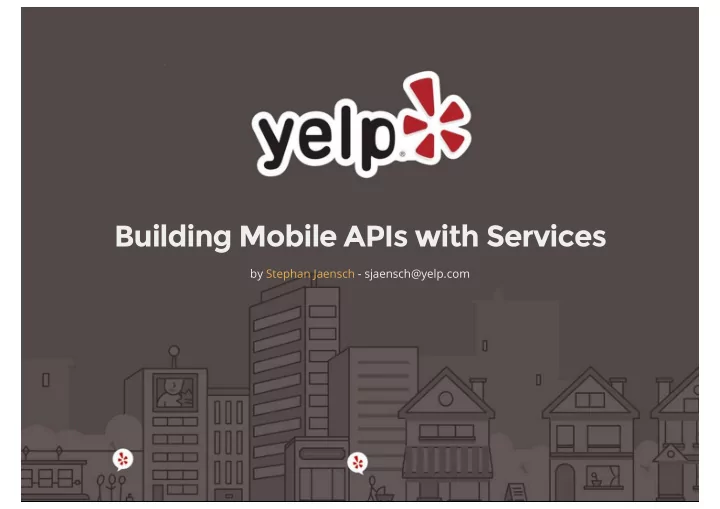

Building Mobile APIs with Services by Stephan Jaensch - sjaensch@yelp.com
What's Yelp? connect people with great local businesses website, apps, mobile site 142 million monthly unique visitors 77 million reviews
Yelp for Biz Owners measure visitor activity on your page interact with customers upload photos
whoami backend developer for the Biz Owner App worked on the main Yelp app backend before that Python user since 2008 did a lot of Django work in the past
Yelp: a brief history lesson founded in 2004 all code in one central repository (‘yelp-main’) web, mobile web, mobile backend, business owner site a lot of homegrown code new abstractions introduced without removing the old ones as Yelp grew, this started to become a bottleneck
The Yelp push process Code deployments (“pushes”) are done several times a day Run by a pushmaster, an engineer with production system access People join a push (“pickme”)
Running a push Automatic checks make sure there are no merge conflicts deployment branch is deployed to a stage system after verification, it’s sent to production ~2 hour process, with no upper bound
Modularize you can run only so many pushes a day so let’s build services!
Why Services? each service is developed and deployed independently services are usually small, covering only one aspect or set of features easy to parallelize thanks to async HTTP requests, so it might even speed your code up http://bit.do/fowler-service http://bit.do/microservices https://github.com/Yelp/service-principles
Why Not Services?
Why Not Services? consistency is really hard no clear dependency / usage graph need to maintain interfaces “forever” testing one huge, mostly self-contained codebase is easy; how do you test services?
How to make sure it doesn't break unittests ...are great, but not enough a lot of breakage if interfaces change our solution: acceptance tests as close to production as possible without using dedicated stage environments
Testing SOA at Yelp spin up all components you need, using production code done with docker-compose heavyweight: take time to run, setup grows with the number of services you call
Setting up acceptance testing configs: internalapi: build: acceptance/configs/ image: docker-dev/internalapi-testing volumes: links: - "./logs:/tmp/logs" - gearman - memcache bizapp: - databaseprimary build: . - databaseaux links: - databasebatch - bizfeed - geocoderservice - businessmedia environment: - internalapi YELP_USE_GEARMAND: True - sessionsservice - ruleserv volumes_from: - configs ports: - 13849
The Yelp service stack originally we used tornado; didn’t work well now: Pyramid, uWSGI, SQLAlchemy HTTP and JSON for communication Swagger to specify the API and do the inter-service calls
Swagger does request and response validation data structure and basic type checking of the individual fields works dynamically by reading a service’s spec, no need to generate and update client libraries
The Biz App service a special snowflake since it’s one of the very few services reachable from the outside not constrained to one area (like business media) no local datastore oftentimes just a proxy, calling yelp-main and other services
The Biz App service API RESTy model one resource per endpoint do multiple calls (to different endpoints) to fetch related resources get concurrency for free (if using async calls) some say a lot of simple calls are easier to scale than fewer complicated ones
The Biz App service API one endpoint per client (app) page for write (POST) endpoints, also send the client the data it needs to display the follow-up page aggregate and enrich data we retrieve from yelp-main and other services a high-level interface that translates to our low-level service APIs
Developing a mobile app backend mobile apps have releases in our case, they’re synchronized, both in time and in features iOS apps need to be reviewed; might take 10+ days you probably also want to test before releasing meaning: API needs to be done sooner than client implementation way sooner than release date
It's not web development you can’t upgrade apps whenever you upgrade the server actually, some users never upgrade so your APIs need to be backwards compatible - forever
Multi-version API maintaining multiple versions can become costly adding fields is backwards compatible
Monitoring number of requests, server errors, task queues, sent push notifications… ElastAlert: it's open source! app crashes: Crashlytics you need an on-call rotation: we use PagerDuty
More about services @Yelp Scott Triglia : Arrested Development - surviving the awkward adolescence of a microservices-based application Friday, 11am, Python Anywhere room
The shameless plugs We’re hiring! Check out yelp.com/careers Interested? Contact me even if you don’t find an open job position that fits you, we’re always looking for talented people! yelp.com/engineering aggregates the blog posts, open source projects and more follow us on Twitter: @Yelp, @YelpEngineering
Have fun and win prizes The Yelp Dataset Challenge: yelp.com/dataset_challenge Want to work with data, but have no data lying around?
THANK YOU questions?
Recommend
More recommend